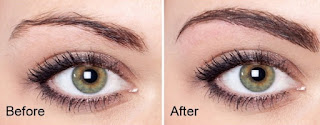Microblading
Microblading, also known by a variety
of names such as eyebrow embroidery, microstroking, feather touch and hair like
strokes is a form of permanent makeup that provides a means to partially or
fully camouflage missing eyebrow hair with the appearance of simulated hair
using fine deposits of cosmetic tattoo pigments. The technique of implanting
pigment after the creation of fine incisions in the skin may date back
thousands of years however the trend towards using the technique for eyebrows emerged
in Asia and was known as feathering or embroidery prior to becoming known as
microblading. Dr. Linda Dixon coined the term "microstroking" which
is used synonymously with microblading.
Microblading is performed by
depositing pigment superficially in the upper region of the dermis with the use
of a hand tool with attached needles fused together in a curvilinear grouping,
and may involve the use of a machine with a specially devised hygienic needle
cartridge. Similar to Permanent Makeup brow treatments using a machine, the
Microblading technique involves drawing individual, crisp hair strokes that can
be very natural looking. However, over time the strokes can blur and fade and
will need to be refreshed.
Microblading is a form of cosmetic tattooing. Some
microblade needle groupings may contain needles that are extremely fine in
diameter in comparison to the needles used in traditional tattooing however
recent advancements in cosmetic tattoo needle technology has also produced
extremely fine needles gauges for machine use. Technicians usually use topical
anesthetics to limit discomfort and consequently like all forms of cosmetic
tattooing if performed correctly the procedure causes minimal discomfort.
Microblading is a tattoo. Pigment is deposited into the upper layers of the
skin, dermis, so as to make the pigment last. If tattoo ink is used, the
strokes will be indelible and likely spread and turn bluish gray. The tattoo,
the same as all other tattoos, will fade depending on the pigment used, the
environment and skincare products used. In order to keep the color crisp, a
touch-up service is required up to every 2 years depending on the individual's
skin and how well it holds the pigment. The needles used come in a variety of
diameters so that the thickness of each individual hair stroke can be
customized to each client depending on the width of their natural hairs as to
make the microblading process look more natural.
Microblading should be performed
using aseptic technique, needles must always be sterile and single use, the
technician must disinfect the area of the skin prior to the tattoo service and
clinical grade single use associated equipment and consumables are highly
recommended (hand piece, skin wipes and saline, micro-brushes, dressing packs
etc.) preferably sterile. The most common complications and client
dissatisfaction that results from any form of tattooing is misapplication of
the pigment, pigment migration and color change. Serious complications are
uncommon though it is important to stress that like all forms of tattooing
risks associated with Microblading include the transmission of Blood Borne
Pathogenic Organisms (e.g. HIV, Hepatitis C Virus) as well as short term or
long terms reactions to pigment ingredients. Therefore, it is essential to
check that the technician holds appropriate licenses and registrations for the
provision of tattoo services as well as inquiring about the standard of
training that has been attained by the technician.
There is not yet a standard for
independent testing of Microblading Professionals. However, the Board of
Microblading is being formed complete with examination and requirements of
training, a knowledge of the basics of sanitation, Bloodborne Pathogen
Certificate, Color Theory, Techniques, Safe needles (such as the hygienic
cartridge microblading needle with retractable "no stick"
design", and healed photographs of work completed. Members will be listed
online for the public to refer to for qualification and location of a
microblading professional near them.
Procedures performed by technicians
who have completed a comprehensive course of instruction can minimize the
risk of unwanted outcomes and client dissatisfaction.
How Microblading Works:
This technique is a process that may
be used to improve or create eyebrow definition, to cover gaps of lost hair, to
extend the eyebrows, or may be used as a full reconstruction if the brows have
little/no hair. Each microblading stroke is applied individually, allowing the
tattoo artist/beauty therapist control of the shape, color and density of the
completed eyebrows.
The treatment begins with developing
the desired shape, then using individual tattoo strokes or 'feathers' in the
area to plot the shape and style requested. The color choice is patient
specific and is mixed using a natural selection of semi-permanent micropigments
to complement hair color and skin tone. Varying shades of hypoallergenic
micropigments react differently with each skin type and fade accordingly,
depending on skin regimen, sun exposure, environmental and after care
precautions. Immediately post treatment, eyebrows will appear darker than
expected, but will fade 50% during the healing process over the following 2
weeks. The 2nd application 6 weeks later includes a touch up to ensure micro-pigments
are healing properly and responding well.
Microblading, although
semi-permanent, lasts between 6–18 months if proper aftercare instructions
are maintained. The treatment is typically a 2 step application process, the
initial appointment includes consultation and initial application, the second
appointment is 6 weeks to touch up and ensure longevity of the colors used.
Source: wikipedia.org



No comments:
Post a Comment